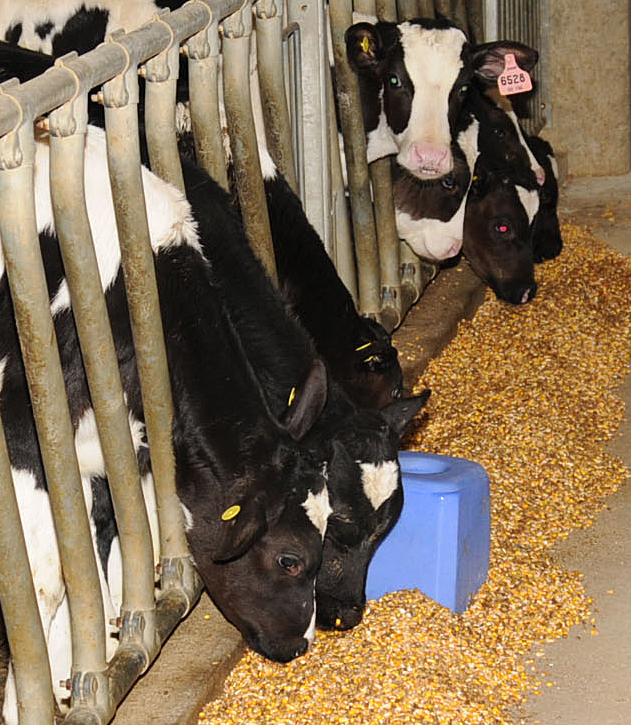Healthy Calf Conference
Follow to stay up-to-date on all Healthy Calf Conference updates. Speaker announcements, sponsorship information, registration announcements, and more.
Weaning is one of the most stressful times for calves, and successful weaning management is essential to ensuring a smooth transition from a liquid to a solid diet. To avoid problems such as reduced growth rates, weight loss, and diarrhea at the time of weaning, there are a variety of management strategies to combat these issues.
The key to a smooth transition at weaning lies with the rumen development. As the calf begins to eat solid feed, the rumen starts to become populated with microbes, this allows for fermentation of the solid feed which promotes development of the rumen wall. The more solid feed a calf eats, the more the rumen will develop to supply the calf with the necessary nutrients for growth and development. So getting calves to eat more grain before weaning is key to a smooth transition and reducing a post-weaning growth lag. However, calves should be fed about 20% of their body weight in milk or milk replacer for the first month of life. Limiting milk intake to promote grain intake is not recommended since pre-weaning growth is associated with improved milk production in the first lactation.

To help promote grain intake it is recommended that calves have access to grain when they are over two weeks of age. Calves under three weeks old eat very little grain; therefore the weaning process should not begin before the calf is four weeks of age since the rumen will not have a chance to develop. Research investigating weaning ages and rumen development found at four weeks of age, the concentration of short chain fatty acids, a product of rumen fermentation, in the rumen fluid was very low suggesting the rumen is only just starting to develop1. Weaning earlier than four weeks can have some big welfare and economic implications since calves will show signs of hunger, show stress related behaviours such as vocalizations and cross sucking, and will have reduced growth rates or even weight loss.
Water is another essential component that will help improve dry matter intake and facilitate a smooth transition at weaning. When a calf ingests water it ends up in the rumen, whereas the milk ends up directly in the abomasum. With water in the rumen and a bit of starter, the ideal environment for microbial fermentation is created. Offering water to calves helps promote starter intake and rumen development, and therefore increases weight gains. Water is especially important in the summer months since it will help keep calves cool, but it should be provided year round. ProAction, is a quality and sustainability program for Canadian dairy farmers, which includes various components such as milk quality, food safety, animal care, livestock traceability, and environmental sustainability, requires that ad libitum water is provided daily to all calves.
How you house your calves can also have a big impact on weaning. More and more research is now looking at the impact of group housing on feed intake, growth, and animal welfare. The data is showing that group housing calves from a young age is beneficial for promoting feed intake and growth as well as reducing the stress associated with weaning. When calves are paired or group housed the thought is that they learn from each other to eat the starter. Research from the University of British Columbia found that calves housed in pairs starting at around one week of age started eating grain sooner and ate more of it than individual housed calves2. Those pair housed calves also had increased body weight, and average daily gain throughout the weaning period.
When it comes time to wean the calves, it is best to do so gradually. Calves that are gradually weaned tend to have better feed intake, better weight gains, and prevented weight loss, and reduced cross sucking and signs of hunger. It is better to gradually reduce the amount of milk at each feeding rather than reducing the number of meals. Based on the recommendations outlined in ProAction, calves should be gradually weaned over a period of five to fourteen days.
Calves are the future of the heard and how calves are fed and managed can have a big impact on performance through the first lactation. Reducing illnesses and stress for calves is key for growing healthy calves for replacements. Since weaning is such a stressful time, implementing management strategies such as gradual weaning, group housing, and providing access to starter and water is essential for improving the overall health, welfare and economical potential of the calves.
References
Follow to stay up-to-date on all Healthy Calf Conference updates. Speaker announcements, sponsorship information, registration announcements, and more.
The Codes of Practice are nationally developed guidelines for the care and handling of farm animals. They serve as our national understanding of animal care requirements and recommended practices.